15 ответов
Я нашел ответ. Проблема заключалась в том, что я должен предшествовать имени таблицы с именем схемы. то есть команда должна быть:
Похоже, ваш сеанс MySql имеет параметр safe-updates. Это означает, что вы не можете обновлять или удалять записи без указания ключа (например, primary key ) в предложении where.
Или вы можете изменить свой запрос, чтобы следовать правилу (используйте primary key в where clause ).
Перед выполнением команды UPDATE выполните следующие действия: В Workbench MySQL
- Перейдите к Edit → Preferences
- Перейдите на вкладку «SQL Editor» и uncheck «Безопасные обновления» check box
- Query → Reconnect to Server //выход из системы, а затем вход в систему
- Теперь выполните ваш SQL-запрос
стр., нет необходимости перезапускать демон MySQL!
Все, что необходимо: Запустите новый запрос и запустите:
Затем: Запустите запрос, который вы пытались запустить, который ранее не работал.
Нет необходимости устанавливать SQL_SAFE_UPDATES в 0, я бы очень не рекомендовал делать это таким образом. SAFE_UPDATES по умолчанию включен для ПРИЧИНЫ. Вы можете управлять автомобилем без ремней безопасности и прочего, если вы понимаете, что я имею в виду;) Просто добавьте в предложение WHERE значение KEY, которое соответствует всему, как первичный ключ, по сравнению с 0, поэтому вместо записи:
Теперь вы можете быть уверены, что каждая запись (ВСЕГДА) обновляется, как вы ожидаете.
- Preferences.
- «Безопасные обновления».
- Перезапустить сервер

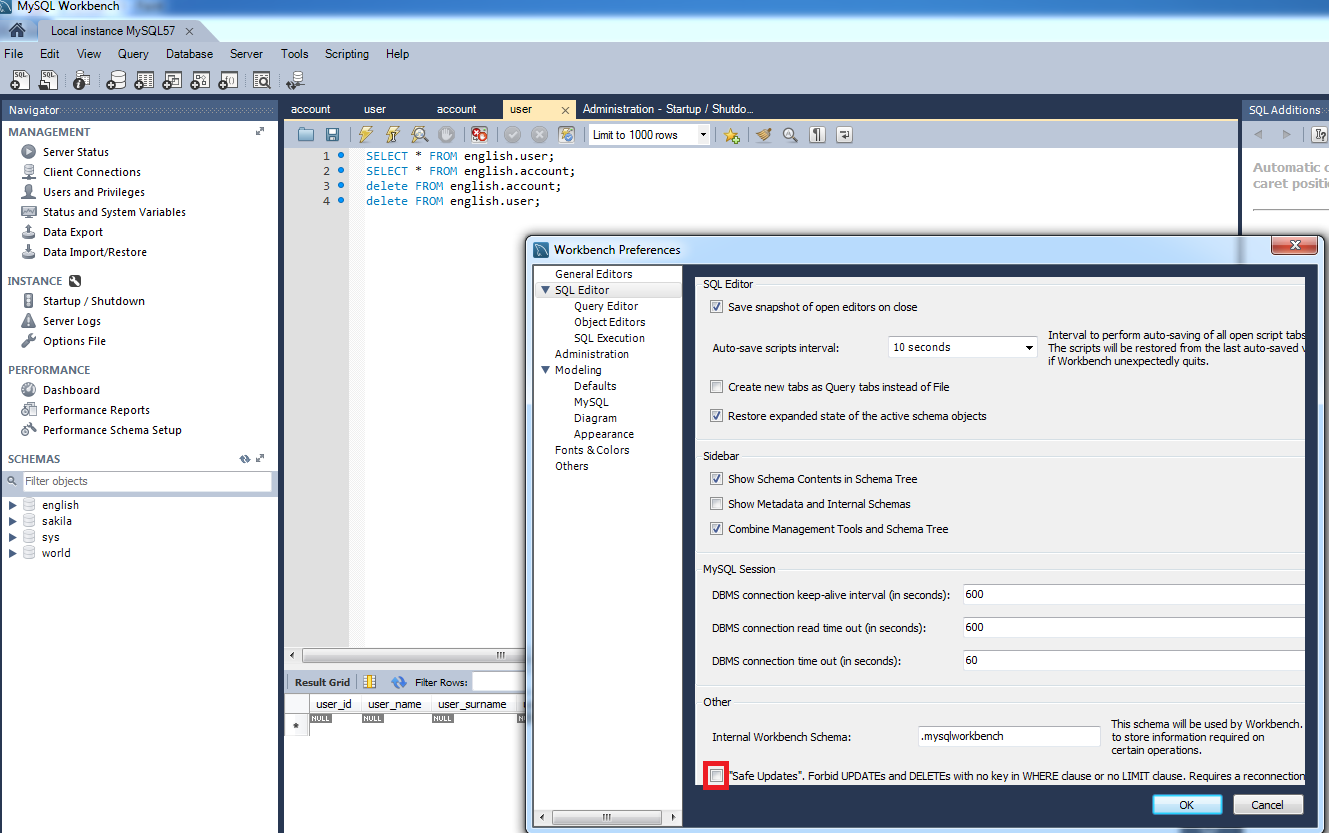
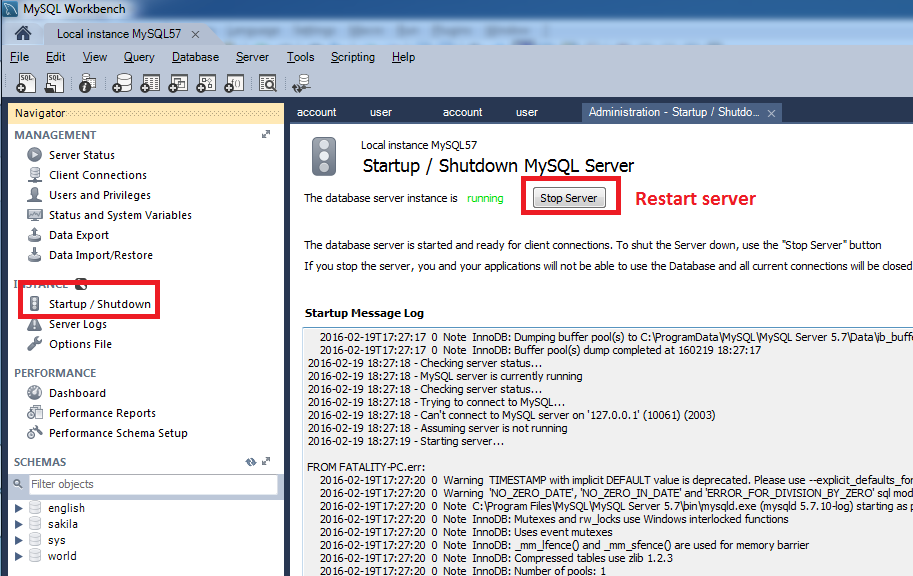
Перейти к Edit —> Preferences
Установите флажок SQL Queries и снимите флажок Safe Updates
Query —> Reconnect to Server
Теперь выполните свой SQL-запрос
Код ошибки: 1175. Вы используете безопасный режим обновления, и вы попытались обновить таблицу без WHERE, которая использует столбец KEY. Чтобы отключить безопасный режим, переключите опцию в Preferences → Editor SQL и снова подключите.
Отключить «Безопасный режим обновления»
Отключить «Безопасный режим обновления» навсегда
Mysql workbench 8.0:
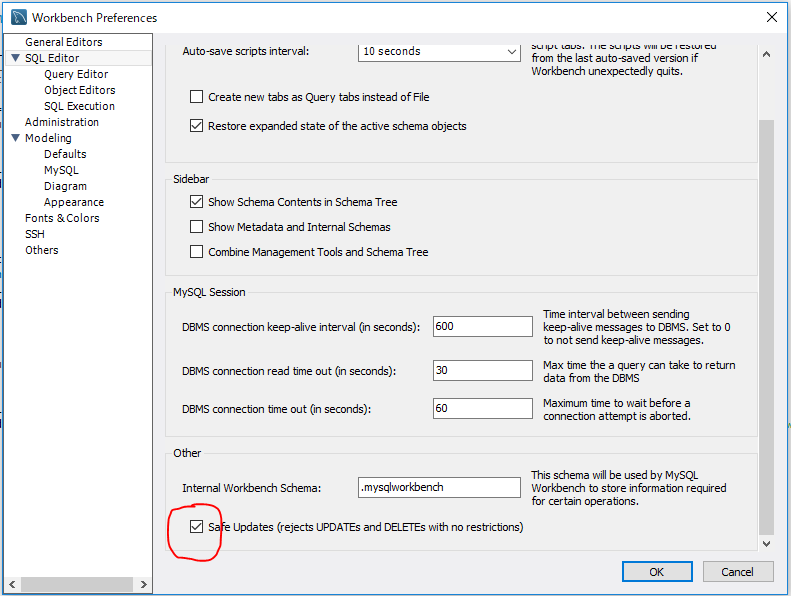
Если вы находитесь в безопасном режиме, вам нужно указать id в разделе where. Так что-то вроде этого должно работать!
В MySQL Workbech версии 6.2 не выходит из настроек SQLQueries .
В этом случае можно использовать: SET SQL_SAFE_UPDATES=0;
Простейшим решением является определение предела строки и выполнения. Это делается в целях безопасности.
Правда, это бессмысленно для большинства примеров. Но, наконец, я пришел к следующему утверждению, и он отлично работает:
Поскольку вопрос был дан ответ и не имел никакого отношения к безопасным обновлениям, это может быть неправильное место; Я отправлю только для добавления информации.
Я старался быть хорошим гражданином и модифицировал запрос, чтобы использовать временную таблицу идентификаторов, которые будут обновляться:
Failure. Изменено обновление до:
Это сработало. Ну, golly — если я всегда добавляю, где ключ 0, чтобы обойти безопасную проверку обновлений или даже установить SQL_SAFE_UPDATE = 0, то я потерял «чек» в моем запросе. Я мог бы просто отключить опцию навсегда. Я полагаю, что он делает удаление и обновление двухэтапного процесса вместо одного.. но если вы набираете достаточно быстро и перестаете думать о том, что ключ является особенным, а скорее как неприятность..
Это для Mac, но должно быть одинаковым для других ОС, кроме местоположения настроек.
Ошибка, возникающая при попытке выполнить небезопасную операцию DELETE
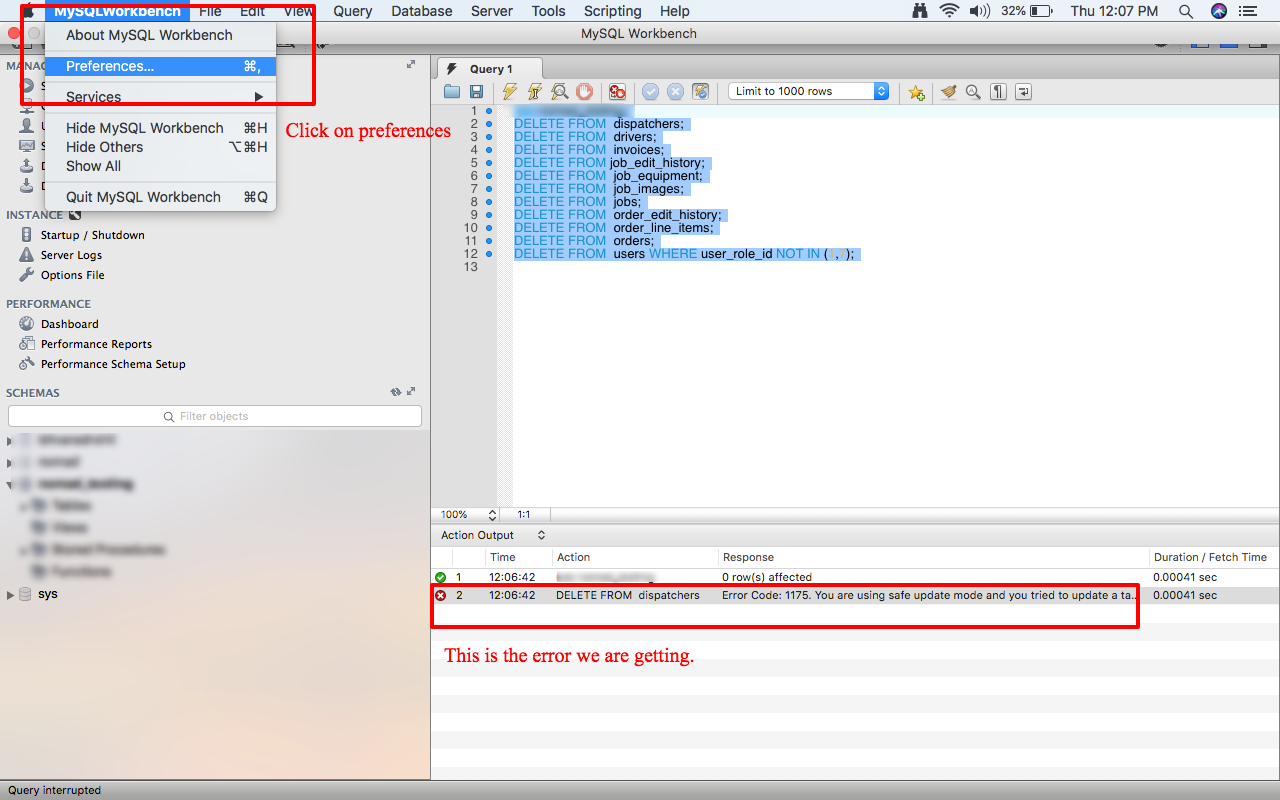
В новом окне снимите флажок » Safe updates
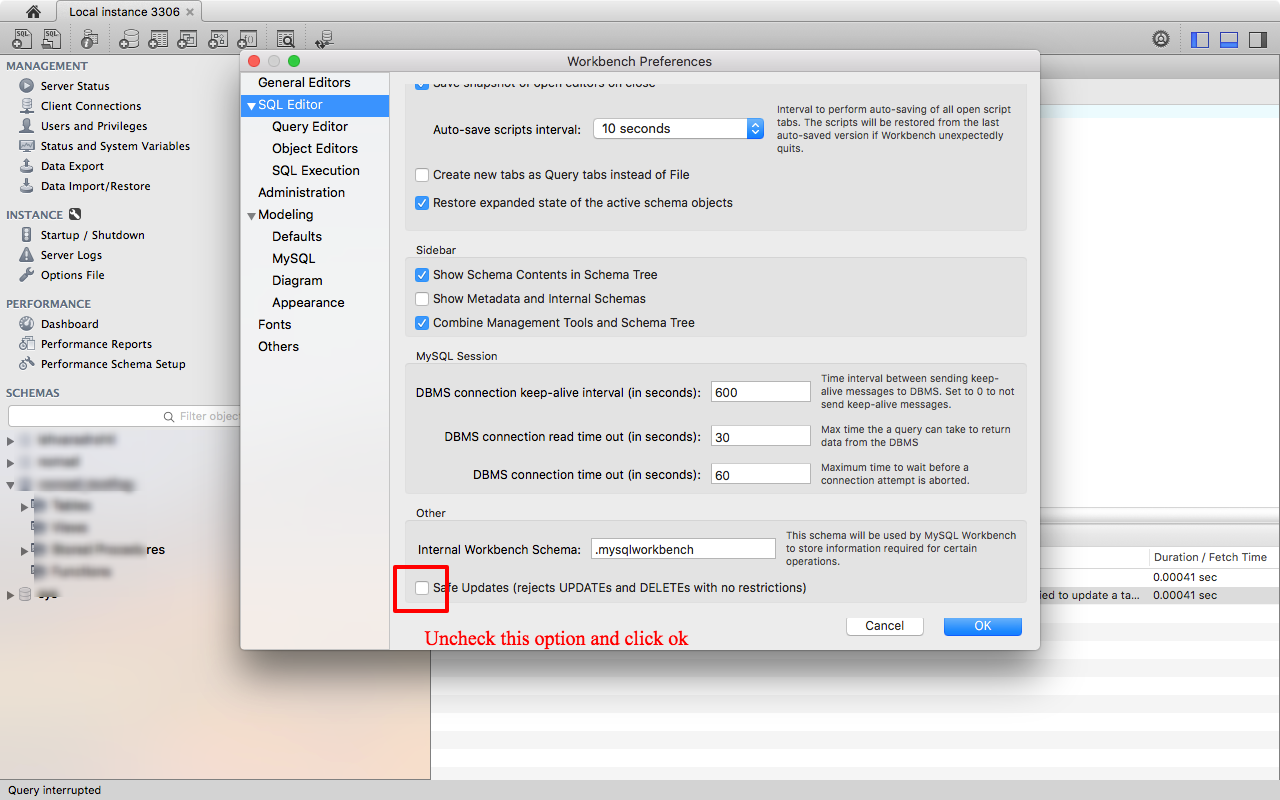
Затем закройте и снова откройте соединение. Не нужно перезапускать службу.
Теперь мы снова попробуем DELETE с успешными результатами.
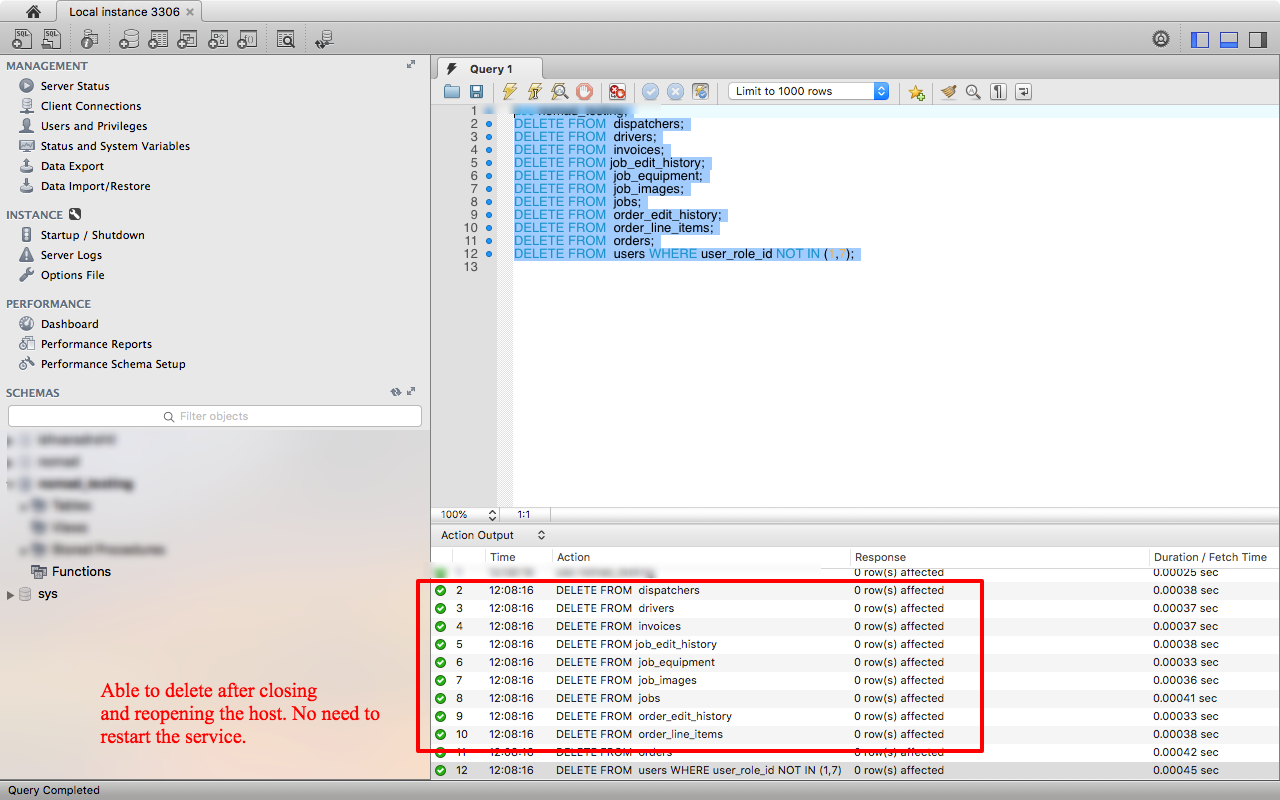
Так что же это за безопасные обновления? Это не зло. Об этом говорит MySql.
Использование опции —safe-updates
Когда вы используете параметр —safe-updates , mysql выдает следующую инструкцию при подключении к серверу MySQL:
Безопасно включать эту опцию при работе с производственной базой данных. В противном случае вы должны быть очень осторожны, не случайно удаляя важные данные.
How do I fix it?
Obviously, one needs to determine how it is that the command violates MySQL’s grammar. This may sound pretty impenetrable, but MySQL is trying really hard to help us here. All we need to do is…
Read the message!
MySQL not only tells us exactly where the parser encountered the syntax error, but also makes a suggestion for fixing it. For example, consider the following SQL command:
That command yields the following error message:
MySQL is telling us that everything seemed fine up to the word WHERE , but then a problem was encountered. In other words, it wasn’t expecting to encounter WHERE at that point.
Messages that say . near » at line. simply mean that the end of command was encountered unexpectedly: that is, something else should appear before the command ends.
Examine the actual text of your command!
Programmers often create SQL commands using a programming language. For example a php program might have a (wrong) line like this:
If you write this this in two lines
then you can add echo $query; or var_dump($query) to see that the query actually says
Often you’ll see your error immediately and be able to fix it.
Obey orders!
MySQL is also recommending that we «check the manual that corresponds to our MySQL version for the right syntax to use«. Let’s do that.
I’m using MySQL v5.6, so I’ll turn to that version’s manual entry for an UPDATE command. The very first thing on the page is the command’s grammar (this is true for every command):
The manual explains how to interpret this syntax under Typographical and Syntax Conventions, but for our purposes it’s enough to recognise that: clauses contained within square brackets are optional; vertical bars | indicate alternatives; and ellipses . denote either an omission for brevity, or that the preceding clause may be repeated.
We already know that the parser believed everything in our command was okay prior to the WHERE keyword, or in other words up to and including the table reference. Looking at the grammar, we see that table_reference must be followed by the SET keyword: whereas in our command it was actually followed by the WHERE keyword. This explains why the parser reports that a problem was encountered at that point.
A note of reservation
Of course, this was a simple example. However, by following the two steps outlined above (i.e. observing exactly where in the command the parser found the grammar to be violated and comparing against the manual’s description of what was expected at that point), virtually every syntax error can be readily identified.
I say «virtually all», because there’s a small class of problems that aren’t quite so easy to spot—and that is where the parser believes that the language element encountered means one thing whereas you intend it to mean another. Take the following example:
Again, the parser does not expect to encounter WHERE at this point and so will raise a similar syntax error—but you hadn’t intended for that where to be an SQL keyword: you had intended for it to identify a column for updating! However, as documented under Schema Object Names:
error code 1175 during UPDATE in MySQL Workbench — MySQL DBA Tutorial
4633
65
13
00:04:16
23.11.2018
Error Code: 1175. You are using safe update mode and you tried to update a table without a WHERE that uses a KEY column. To disable safe mode, toggle the option in Preferences is the error you get when you have «Safe update» setting enables in MySQL Workbench.
To disable, you can follow below steps
Go to Edit Preferences
Click «SQL Editor» tab and uncheck «Safe Updates» check box
Query Reconnect to Server // logout and then login
Now execute your SQL query
To follow step by step tutorial for MySQL DBA for beginner to Advance
🤍
MySQL Workbench 8.0.13 Tutorial
MySQL DBA Certification Training
MySQL DBA Tutorial Step by Step
MySQL DBA Training online free
MySQL Real Time DBA Tutorial
MySQL Administration Course step by Step
MySQL Tools for Development and Admin
How we fix this error?
Recently, one of our customers approached us saying that he is getting Error Code 1175 while executing a DELETE query. When we checked we found that the safe update option is turned ON. So we set a safe update option OFF.
Then we tried deleting the records from the table he mentioned using:
This deleted the table successfully.
We also handled a situation where the customer approached us saying that he wants to disable sql_safe_updates option as he is getting an error like the one shown below:
The customer said, he doesn’t know from where he has to disable it in GUI. So our Support Engineers asked him to follow the steps below for disabling.
- Initially, access the Edit option.
- There click on the Preferences option available.
- Then, click on the SQL Editor tab. Within this tab, uncheck Safe Updates checkbox and click OK.
- There you can see Query and Reconnect to Server.
- Then, login and finally logout
проверил!! Что делает #1064 mean?
ошибка посмотреть как gobbledygook, но они (часто) невероятно информативны и предоставляют достаточные детали, чтобы точно определить, что пошло не так. Понимая точно, что MySQL говорит вам, вы можете вооружиться, чтобы исправить любую проблему такого рода в будущем.
как и во многих программах, ошибки MySQL кодируются в соответствии с тип проблемы, которая произошла. ошибка #1064 ошибка синтаксиса.
что это «синтаксис», о котором вы говорите? Это колдовство?
в то время как «синтаксис» — это слово, которое многие программисты сталкиваются в контексте компьютеры, по сути, заимствованы из более широкой лингвистики. Это относится к структуре предложения, т. е. правила грамматики; или, другими словами, правила, определяющие, что составляет действующий приговор в рамках языка.
например, следующее английское предложение содержит синтаксическую ошибку (поскольку неопределенная статья » a » всегда должна предшествовать существительному):
какое это имеет отношение к MySQL?
всякий раз, когда кто-то выдает команду компьютеру, одна из самых первых вещей, которые он должен сделать, это «разобрать» эту команду, чтобы понять ее. «Синтаксическая ошибка» означает, что синтаксический анализатор не может понять, что спрашивается, потому что он не представляет собой допустимую команду в языке: другими словами, команда нарушает грамматику программирования язык.
важно отметить, что компьютер должен понять команду, прежде чем он сможет что-либо с ней сделать. Поскольку есть синтаксическая ошибка, MySQL понятия не имеет, что нужно, и поэтому отказывается прежде чем он даже выглядит по базе данных и поэтому схема или содержимое таблицы не имеют значения
Перенос базы на другой сервер.
У вас есть дамп (т.е. файл с расширением .sql) и при попытке его импортировать вы получаете ошибку 1064. Причины:
-
В различных версиях набор ключевых слов и синтаксис может немного отличаться. Наиболее распространенный случай: команда create table, в которой ключевое слово type было заменено на engine. Например, если вы получаете ошибку:
You have an error in your SQL syntax; check the manual that corresponds to your MySQL server version for the right syntax to use near ‘TYPE=MyISAM CHARACTER SET `utf8`’ at line 29
Это означает, что вы переносите базу в пятую версию сервера MySQL, в котором ключевое слово TYPE не поддерживается и его нужно заменить на ENGINE.
Редко бываю случаи, когда перенос идет на старый (~3.23) сервер, который кодировки не поддерживает. Тогда ошибка будет иметь вид:
#1064 — You have an error in your SQL syntax near ‘DEFAULT CHARACTER SET cp1251 COLLATE cp1251_general_ci’ at line 1
Такое может произойти, если вы переносите базу с хостинга на локальный комп, где стоит древняя версия MySQL. Лучшим решением в данном случае будет не править дамп, а обновить MySQL.
-
Часто проблемы вызваны тем, что дамп делается неродными средствами MySQL (например, phpmyadmin) из-за чего в нем могут быть BOM-маркер, собственный синтаксис комментариев, завершения команды и т.д. Кроме того при использовании того же phpmyadmin возможна ситуация при которой из-за ограничения апача на размер передаваемого файла команда будет обрезана, что приведет к ошибке 1064.
Например, если вы получаете ошибку:#1064 — You have an error in your SQL syntax; check the manual that corresponds to your MySQL server version for the right syntax to use near ‘CREATE TABLE `jos_banner` (
`bid` int(11) NOT NULL auto_increment,
`ci’ at line 1Значит ваш дамп содержит BOM-маркер. Это три байта в начале файла, помогающие программе определить что данный файл сохранен в кодировке UTF-8. Проблема в том, что MySQL пытается интерпретировать их как команду из-за чего возникает ошибка синтаксиса. Нужно открыть дамп в текстовом редакторе (например, Notepad++) и сохранить без BOM.
Для избежания подобных проблем при создании дампа и его импорте лучше пользоваться родными средствами MySQL, см http://sqlinfo.ru/forum/viewtopic.php?id=583
Aaaagh!! What does #1064 mean?
Error messages may look like gobbledygook, but they’re (often) incredibly informative and provide sufficient detail to pinpoint what went wrong. By understanding exactly what MySQL is telling you, you can arm yourself to fix any problem of this sort in the future.
As in many programs, MySQL errors are coded according to the type of problem that occurred. Error #1064 is a syntax error.
What is this «syntax» of which you speak? Is it witchcraft?
Whilst «syntax» is a word that many programmers only encounter in the context of computers, it is in fact borrowed from wider linguistics. It refers to sentence structure: i.e. the rules of grammar; or, in other words, the rules that define what constitutes a valid sentence within the language.
For example, the following English sentence contains a syntax error (because the indefinite article «a» must always precede a noun):
What does that have to do with MySQL?
Whenever one issues a command to a computer, one of the very first things that it must do is «parse» that command in order to make sense of it. A «syntax error» means that the parser is unable to understand what is being asked because it does not constitute a valid command within the language: in other words, the command violates the grammar of the programming language.
It’s important to note that the computer must understand the command before it can do anything with it. Because there is a syntax error, MySQL has no idea what one is after and therefore gives up before it even looks at the database and therefore the schema or table contents are not relevant.
How we fix this error?
Recently, one of our customers approached us saying that he is getting Error Code 1175 while executing a DELETE query. When we checked we found that the safe update option is turned ON. So we set a safe update option OFF.
Then we tried deleting the records from the table he mentioned using:
This deleted the table successfully.
We also handled a situation where the customer approached us saying that he wants to disable sql_safe_updates option as he is getting an error like the one shown below:
The customer said, he doesn’t know from where he has to disable it in GUI. So our Support Engineers asked him to follow the steps below for disabling.
- Initially, access the Edit option.
- There click on the Preferences option available.
- Then, click on the SQL Editor tab. Within this tab, uncheck Safe Updates checkbox and click OK.
- There you can see Query and Reconnect to Server.
- Then, login and finally logout
How to fix MySQL ERROR code 1175 safe update mode
Posted on Oct 13, 2021
Learn how to fix MySQL ERROR code 1175 in the command line and MySQL Workbench
MySQL ERROR code 1175 is triggered when you try to update or delete a table data without using a WHERE clause.
MySQL has a safe update mode to prevent administrators from issuing an UPDATE or DELETE statement without a WHERE clause.
You can see if safe update mode is enabled in your MySQL server by checking the global variable sql_safe_updates .
Check the global variable using the SHOW VARIABLES statement as follows:
The example above shows that sql_safe_updates is turned ON , so an UPDATE or DELETE statement without a WHERE clause will cause the error 1175.
Here’s an example UPDATE statement that causes the error:
To fix the error, you can either disable the safe update mode or follow the error description by adding a WHERE clause that uses a KEY column.
You can use the SET statement to disable the safe update as shown below:
Now you should be able to execute an UPDATE or DELETE statement without a WHERE clause.
If you want to turn the safe update mode back on again, you can SET the global variable to 1 as shown below:
If you’re using MySQL Workbench to manage your database server, then you can disable the safe update mode from the Preferences menu.
Click on Edit -> Preferences for Windows or MySQLWorkbench -> Preferences for Mac.
Then click on SQL Editor tab and uncheck the Safe updates feature:
Keep in mind that updating or deleting a table without a WHERE clause will affect all rows in that table.
The safe update mode is added to prevent accidental change that can be fatal.
It’s okay if you’re testing with dummy data, but please be careful with real data
About
Nathan Sebhastian is a software engineer with a passion for writing tech tutorials.Learn JavaScript and other web development technology concepts through easy-to-understand explanations written in plain English.
Источник
How To Fix MySQL WorkBench Error Code 1175 | DISABLE Safe Update Mode Restriction
7625
49
6
00:01:25
28.04.2020
This is How to fix Error Code 1175 in MySQL Workbench. This error happen because you are using safe update mode and you tried to update a table without a WHERE that uses a KEY column.
In short If the checkbox is enabled for Safe Updates it rejects UPDATEs and DELETEs with no Restrictions.
Specifically the Safe Mode option ENABLES the SQL_SAFE_UPDATES option for the session. If enabled, MySQL aborts UPDATE or DELETE statements
That do not use a key in the WHERE clause or a LIMIT clause. This makes it possible to catch UPDATE or DELETE statements where keys are not use properly and that would probably change or delete a large number of rows. Changing this option requires a reconnection.
Subscribe for more content like this:
🤍
About the Content:
«MySQL WorkBench — Disable Safe mode / Safe UPDATE or DELETE in mySQL | Solution for Error Code 1175 | Tookootek | How To #002» is quick fix so it only have 1 part.
Chapters:
00:00 Introduction
00:03 How To Disable Safe Update Mode Walkthrough
01:20 Outro
Playlist
🤍
Как исправить ошибку «Error Code: 1175» в MySQL Workbench
Данную ошибку достаточно легко устранить, так как это всего лишь ограничение, реализованное в целях безопасности.
Давайте рассмотрим способы устранения ошибки «Error Code: 1175» в MySQL Workbench.
Исходные данные
Для начала, чтобы было нагляднее, давайте я покажу, какие исходные данные будут использоваться в примерах.
CREATE TABLE goods (
product_id INT NOT NULL AUTO_INCREMENT PRIMARY KEY,
product_name VARCHAR(100) NOT NULL,
price NUMERIC(18,2) NULL
);
INSERT INTO goods (product_name, price)
VALUES ('Системный блок', 50),
('Клавиатура', 30),
('Монитор', 100),
('Планшет', 150),
('Смартфон', 100);
SELECT * FROM goods;
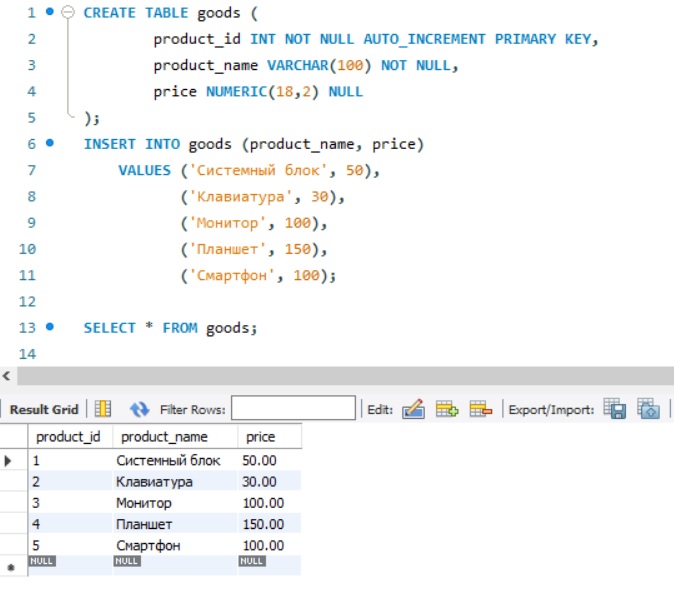
И допустим, у нас появилась задача обновить столбец price у всех записей этой таблицы. Давайте попытаемся это сделать, написав следующий запрос.
UPDATE goods SET price = price + 10;
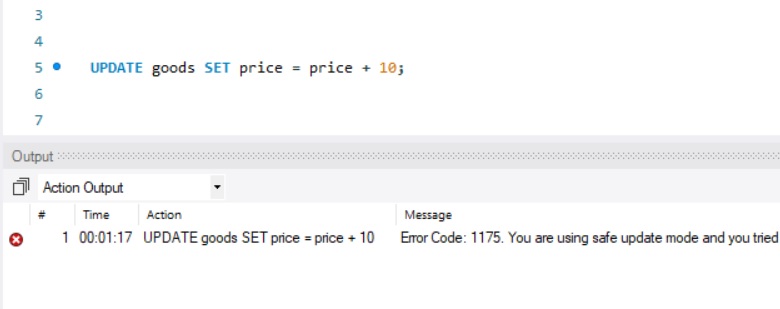
Как видите, у нас возникла ошибка «Error Code: 1175. You are using safe update mode», а данные нам все равно нужно обновить, поэтому давайте исправим эту ситуацию.
Способ 1 – Отключение режима безопасных обновлений
Самым очевидным способом решения проблемы является отключение режима безопасных обновлений.
Например, для отключения этого режима на время сеанса можно использовать следующую инструкцию.
SET SQL_SAFE_UPDATES = 0;
Или зайти в настройки MySQL Workbench Edit -> Preferences -> SQL Editor» и снять галочку Save Updates», тем самым режим безопасных обновлений будет отключен насовсем (чтобы изменения вступили в силу, необходимо перезапустить MySQL Workbench, т.е. переподключиться к MySQL Server).

Однако, так как по умолчанию данный режим все-таки включен, значит, это рекомендуют сами разработчики MySQL, и отключать его не советуют. Поэтому стоит посмотреть на следующие способы решения данной проблемы.
Способ 2 – Использование в условии первичного ключа
Чтобы не трогать сам режим, мы можем просто выполнить требования, которые накладывает данный режим.
Например, в условии WHERE использовать ключ. Для решения нашей задачи мы можем указать product_id > 0.
UPDATE goods SET price = price + 10 WHERE product_id > 0; SELECT * FROM goods;

Мы видим, что запрос успешно выполнился, и все записи обновлены.
Заметка! ТОП 5 популярных систем управления базами данных (СУБД).
Способ 3 – Использование оператора LIMIT
Также можно указать оператор LIMIT, чтобы ограничить строки для обновления, при этом в параметре LIMIT указать число, которое будет больше количества строк в таблице.
UPDATE goods SET price = price + 10 LIMIT 1000; SELECT * FROM goods;

В данном случае также запрос выполнился успешно.
На сегодня это все, надеюсь, материал был Вам полезен, пока!
Нравится31Не нравится3
MySQL Workbench periodically errors on auto-save?
162
1
00:01:25
27.03.2021
MySQL Workbench periodically errors on auto-save?
Helpful? Please support me on Patreon: 🤍
With thanks & praise to God, and with thanks to the many people who have made this project possible! | Content (except music & images) licensed under CC BY-SA 🤍 | Music: 🤍 | Images: 🤍 & others | With thanks to user Jancsiszeg (superuser.com/users/439655), user fixer1234 (superuser.com/users/364367), user Alex R (superuser.com/users/16188), and the Stack Exchange Network (superuser.com/questions/844193). Trademarks are property of their respective owners. Disclaimer: All information is provided «AS IS» without warranty of any kind. You are responsible for your own actions. Please contact me if anything is amiss at Roel D.OT VandePaar A.T gmail.com
MySQL : mysql delete under safe mode
10
00:01:24
23.01.2022
MySQL : mysql delete under safe mode
MySQL : mysql delete under safe mode
Note: The information provided in this video is as it is with no modifications.
Thanks to many people who made this project happen. Disclaimer: All information is provided as it is with no warranty of any kind. Content is licensed under CC BY SA 2.5 and CC BY SA 3.0. Question / answer owners are mentioned in the video. Trademarks are property of respective owners and stackexchange. Information credits to stackoverflow, stackexchange network and user contributions. If there any issues, contact us on — htfyc dot hows dot tech
#MySQL:mysqldeleteundersafemode #MySQL #: #mysql #delete #under #safe #mode
Guide :
How to fix MySQL ERROR code 1175 safe update mode
Posted on Oct 13, 2021
Learn how to fix MySQL ERROR code 1175 in the command line and MySQL Workbench
MySQL ERROR code 1175 is triggered when you try to update or delete a table data without using a WHERE clause.
MySQL has a safe update mode to prevent administrators from issuing an UPDATE or DELETE statement without a WHERE clause.
You can see if safe update mode is enabled in your MySQL server by checking the global variable sql_safe_updates .
Check the global variable using the SHOW VARIABLES statement as follows:
The example above shows that sql_safe_updates is turned ON , so an UPDATE or DELETE statement without a WHERE clause will cause the error 1175.
Here’s an example UPDATE statement that causes the error:
To fix the error, you can either disable the safe update mode or follow the error description by adding a WHERE clause that uses a KEY column.
You can use the SET statement to disable the safe update as shown below:
Now you should be able to execute an UPDATE or DELETE statement without a WHERE clause.
If you want to turn the safe update mode back on again, you can SET the global variable to 1 as shown below:
If you’re using MySQL Workbench to manage your database server, then you can disable the safe update mode from the Preferences menu.
Click on Edit -> Preferences for Windows or MySQLWorkbench -> Preferences for Mac.
Then click on SQL Editor tab and uncheck the Safe updates feature:
Keep in mind that updating or deleting a table without a WHERE clause will affect all rows in that table.
The safe update mode is added to prevent accidental change that can be fatal.
It’s okay if you’re testing with dummy data, but please be careful with real data
About
Nathan Sebhastian is a software engineer with a passion for writing tech tutorials.Learn JavaScript and other web development technology concepts through easy-to-understand explanations written in plain English.
Источник
How can I fix MySQL error #1064?
When issuing a command to MySQL, I’m getting error #1064 «syntax error».
What does it mean?
How can I fix it?

3 Answers 3
-
Read the error message. It tells you exactly where in your command MySQL got confused.
-
Examine your command. If you use a programming language to create your command, use echo , console.log() , or its equivalent to show the entire command so you can see it.
-
Check the manual. By comparing against what MySQL expected at that point, the problem is often obvious.
-
Check for reserved words. If the error occurred on an object identifier, check that it isn’t a reserved word (and, if it is, ensure that it’s properly quoted).
Fix Error you are Using Safe Update Mode in MySQL Workbench | Safe Mode Error | Work Bench |
4430
71
8
00:03:41
13.07.2022
Fix Error you are Using Safe Update Mode in MySQL Workbench | Safe Mode Error | Work Bench |
Complete SQL in One Video :-
🤍
Telegram Link: 🤍
New Channel :- New Channel : — 🤍
Complete Project Playlist :- 🤍
Complete XML In One Video:- 🤍
Complete Interview Question :- 🤍
Complete CSS Playlist :- 🤍
Topics Covered:
mysql error code: 1175 during update in mysql workbench
you are using safe update mode
error code: 1175 you are using safe update mode
fix error code: 1175 you are using safe update mode
workbench
error code 1175 during update in mysql workbench
mysql workbench
safe mode error in mysql workbench
error code 1175 in mysql workbench
mysql error code: 1175 during update
how to remove error 1175 in mysql workbench
mysql safe update mode error in tamil
error code: 1175
#MYSQLSafeMode
#mysqlworkbench #ErrorMysqlworkbench
Disclaimer :
This video is for educational purpose only. Copyright Disclaimer Under Section 107 of the Copyright Act 1976, allowance is made for «FAIR USE» for purposes such as criticism, comment, news reporting, teaching, scholarship, and research. Fair use is a use permitted by copyright statute that might otherwise be infringing. Non-profit, educational or personal use tips the balance in favour of fair use.
Некорректная работа сайта.
Если во время работы сайта появляются ошибки синтаксиса, то, как правило, причина в установке вами сомнительных модулей к вашей cms. Лучшее решение — отказаться от их использования. Еще лучше предварительно проверять их работу на резервной копии.
Пример. Движок dle 7.2, поставили модуль ,вроде бы все Ок, но:
MySQL Error!————————
The Error returned was:
You have an error in your SQL syntax; check the manual that corresponds to your MySQL server version for the right syntax to use near ‘AND approve=’1’ AND date < ‘2008-10-04 04:34:25′ LIMIT 5’ at line 1
Error Number:1064SELECT id, title, date, category, alt_name, flag FROM dle_post WHERE MATCH (title, short_story, full_story, xfields, title) AGAINST (‘Приобретение и оплата скрипта ‘) AND id != AND approve=’1’ AND date < ‘2008-10-04 04:34:25’ LIMIT 5
В данном примере мы видим, что причина ошибки в отсутствии значения после «id != «
Кусок кода, который отвечает за данный запрос это
$db->query («SELECT id, title, date, category, alt_name, flag FROM » . PREFIX . «_post WHERE MATCH (title, short_story, full_story, xfields, title) AGAINST (‘$body’) AND id != «.$row’id’.» AND approve=’1′».$where_date.» LIMIT «.$config’related_number’);
Далее можно искать откуда взялась переменная $row и почему в ней нет элемента ‘id’ и вносить исправления, но лучше отказаться от использования такого модуля (неизвестно сколько сюрпризов он еще принесет).
P.S. Если после прочтения статьи ваш вопрос с MySQL Error 1064 остался нерешенным, то задавайте его на форуме SQLinfo
Все права на данную статью принадлежат порталу SQLInfo.ru. Перепечатка в интернет-изданиях разрешается только с указанием автора и прямой ссылки на оригинальную статью. Перепечатка в бумажных изданиях допускается только с разрешения редакции.

































